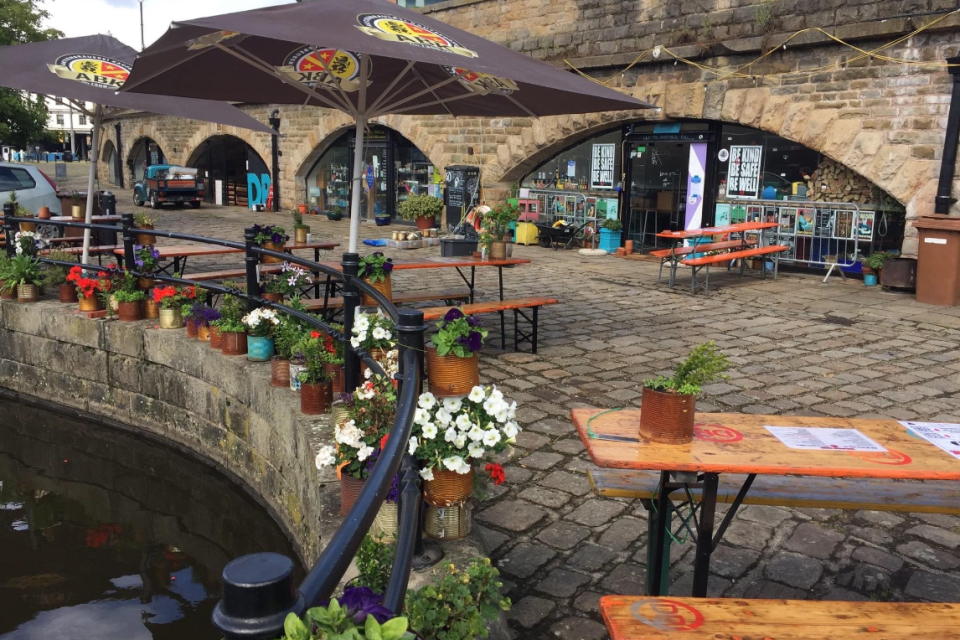For someone well-known for performing in Sheffield’s busiest parks, Zan, a handpan player who “takes people on a sound journey,” is surprisingly shy. Sitting down with Sheffield Wire’s Libby Shaw and Georgina Quach amongst a leafy backdrop, she opened up about her curious journey from handywoman to sound healer.
“As humans, we’re always vibrating and it’s all energy and it’s very powerful,” says Zan. Ever since giving up her 20-year job as a painter-decorator, she has been harnessing the power of music for sound healing, both to comfort others and to keep herself grounded in a fast-changing world. “I have big gongs. Very big ones.”
Meeting Zan
Enveloped in spring blossom and sunshine, Zan was also wrapped up in the melodies which reverberated around her. Zan’s hands delicately danced on the handpan as crowds in the Botanical Gardens looked on. Although passers-by were enthralled by her handpan playing, Zan did not make any pretense of being an expert. She insists she has so much more technical artistry to learn, and her beginner attempts only sound good to those with untrained ears.
“The hardest part, in terms of technique, is making this hand do something different to this one,” said Zan, gesturing. “Your left always wants to follow your right.”
“If you do not do a course or you do not have some kind of knowledge from someone who knows how to play, you are quite limited. It sounds beautiful, but to progress and to create harmonies and your own compositions, it is a different field,” she says. Zan has begun weekly handpa classes held online. 
As well as in the Botanical Gardens, Sheffield residents typically see her playing in Bole Hills, Endcliffe Park and Forge Dam Park. While immersing is important to her practice, she shies away from attention. “I love people, but at a distance,” she laughs.
Inspiration from travels
“The first handpan I had ever heard was in Barcelona, about 15 years ago,” said Zan. “It captured me then when I was traveling and I couldn’t buy one because it’s quite delicate and they’re not easy to transport. So then it just kind of went out of my head.”
With some handpans costing over a £1000, the financial investment was also a barrier, according to Zan. Two years ago, she finally decided to save up and try it herself, turning to YouTube tutorials for learning the basics.
Zan was born in Puglia, Italy. “My mum is English, she’s from Rotherham and most of my schooling was in Sheffield. Growing up, our family was always coming and going — a bit like a gypsy family. Now, I would live a few years here, go somewhere else and then come back here. I don’t usually live in England. I’m away a lot,” she said.
Lockdown has proved a struggle for Zan, a nomadic wanderer who is used to experiencing different cultures. “I’m just kind of trying to stay grounded and where I am at the moment.”
One of Zan’s former dwellings was in the small and rural isle of Gozo, a tranquil retreat nestled in the backwater of its sister island Malta.
“This has been my first year stuck in England, which has been lovely and I have met a lot of beautiful people.” Zan collaborates with Deva Wild, a Kundalini yoga teacher from Sheffield, on restorative retreats, which are held in undisclosed locations.
 “The retreats in drumming,” explains Zan. “You go into a state of total relaxation and the gong specially works on a cellular level, so it kind of changes the structure from inside.”
“The retreats in drumming,” explains Zan. “You go into a state of total relaxation and the gong specially works on a cellular level, so it kind of changes the structure from inside.”
Ms Raj said: “We spend so much of life being stimulated, taking in information and trying to balance life. These events allow education of who you are and how you work.
“They give you the time and space to integrate and process your life. The art of awareness invites presence into your life.”
Stepping back from a money-driven world
A retired self-employed painter-decorator, Zan was used to directing her own occupations in life. “I used to work with an ex partner of mine and we had a really good thing going on because she’s female. So the clients were really interested in having just women in the house, especially female clients,” said Zan.
When the business died down, she embarked on sound therapy. “I was meant to be on a course last year to become a sound therapist but it was cancelled twice.” The certificate is needed if she hopes to work in other areas, such as in care homes and hospices.

Sound healing works from the belief that everything has its own innate vibration and frequency. When these vibrations are out of sync or there is dissonance, sound therapy is a way of bringing them back into alignment. According to the proponents of this therapy, the lower or more discordant the vibration, the more the disturbance and ‘dis-ease’.
Considered an alternative therapy, sound therapy uses specific vibrational frequencies to heal or support the treatment of various physiological, mental and emotional conditions.
Zan does not earn money from her sound healing. “For me, it is not a job because I do not receive payment and I don’t like this money thing…I’m trying to get away from that. I know we need it.”
“At the moment, I just do it voluntarily, you know, and receive other things. You know, I got free yoga classes and other things besides money.” Like the gentle muttering noises swirling through the handpan, this philosophy flows into everything she does, with each melody becoming more sacred as it heals.
By Libby Shaw and Georgina Quach




